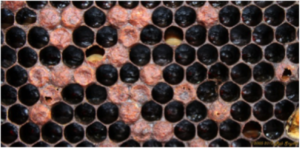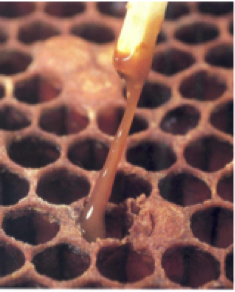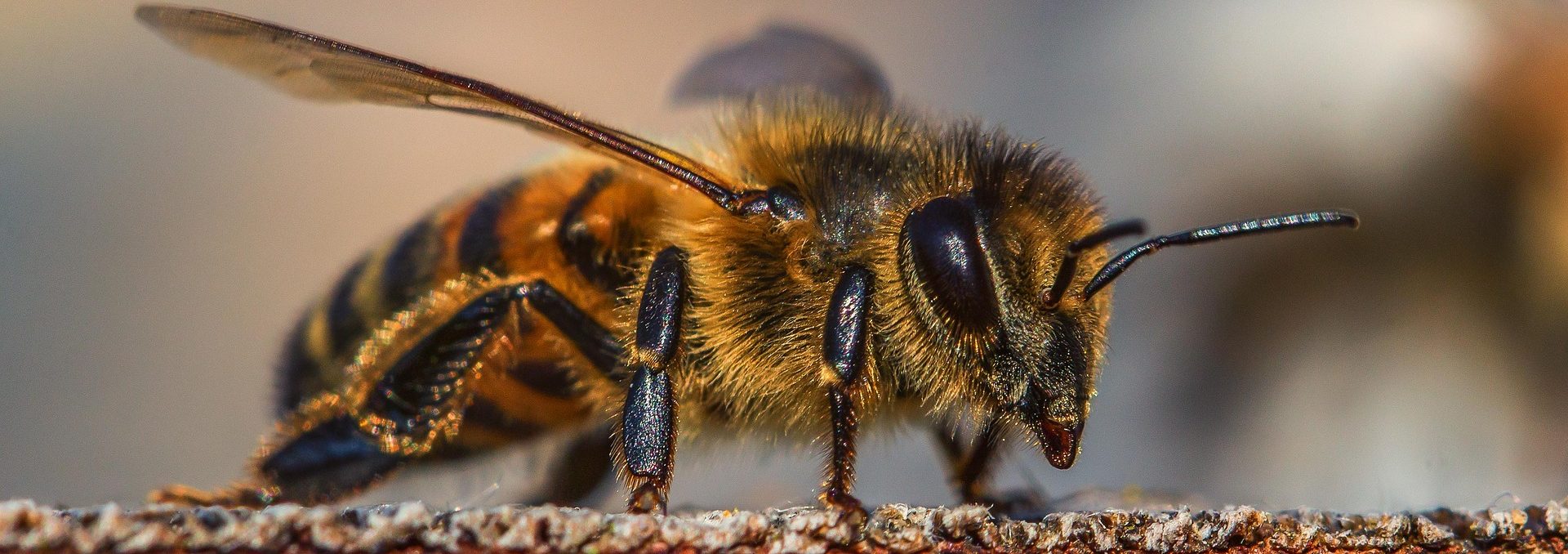American foul-brood (AFB) is a serious infection of honeybee larvae and pupae. Infected bee colonies slowly become weak and die. Early detection of the disease is important because routine apiary management and interchange of hive components can easily spread it to healthy bee colonies.

Brood with AFB infection
Cause and Lifecycle
AFB is caused by the bacterium, Paenibacillus larvae. The spores of this organism cannot be seen by the naked eye.
The disease begins in honeybee larvae after they swallow AFB spores with their food.
Within 24-48 hours, the spores germinate in the gut of the larva and invade the body tissues, killing the infected larva before pupation, usually immediately after the brood cell is capped.
The final stage of the bacterium lifecycle is reached when it forms into spores. Approximately 2,500 million spores may occur in the remains of a single infected honeybee larva.
AFB Spores

AFB Rope test
AFB spores are tough and can remain dormant for at least 50 years and possibly much longer. They can remain dormant on beeswax combs, used hives and components, honey, wax and propolis. They are very resistant to heat, direct sunlight, desiccation, fermentation, chemical disinfectants and veterinary drugs.
Hive Inspection
In healthy colonies, the brood pattern usually appears regular or uniform because the queen has methodically laid eggs across the comb, or in an area formed by a semi-circle or in concentric circles. Sometimes, there may only be a few empty cells interspersed in the area of brood. The caps of cells containing healthy brood are uniform in appearance, generally bright and convex.
If AFB is suspected it is important to obtain an accurate diagnosis. Experience has shown that the diagnosis provided by a fellow beekeeper may not always be accurate. An inaccurate diagnosis can lead to the spread of the disease throughout the apiary and large losses of hives and honey production. Confirmation of AFB may be obtained by laboratory examination.
Management
Keep hives showing signs of disease isolated from hives that appear healthy. Make sure you do not transfer infection. Do not use infected material in healthy hives. Do not transfer combs or any hive components from diseased to healthy hives. Kill infected colonies as soon as practical and either prepare for irradiation or burn infected material in a hole and cover remains with at least 30 cm of soil. See below for details on this process.
Always handle healthy hives before diseased ones.
Do not feed antibiotics to infected hives as this only masks the problem.
Always inspect weaker non-performing colonies to determine the reason.
Do not expose honey to robber bees.
Do not under any circumstances allow infected colonies to die out and allow robber bees access to infected material. This will seriously increase the disease problem in the apiary and surrounding area.
Re-examine your hives every two months to make sure that you have found all the diseased hives.
Robbing
Hives in which bee colonies have died and hives with reduced adult bee populations that are unable to prevent robber bees from entering should be sealed. This includes closing the entrance and any other holes that may allow robber bees to gain entry. Robbing of honey is a major cause of disease spread.
Killing the diseased honey bee colonies
All hive exits should be closed when the bees have stopped flying. Bee flights usually stop around sunset. Apply petrol (half a cup approximately) to a cloth placed under the hive lid or pour petrol directly onto the frames in the top box. Avoid letting bees escape. It is a good idea to tilt the hive from front to back to avoid loss of petrol through the (closed) hive entrance. It may take 5-15 minutes before all bees are dead.
It is extremely important to remember that a bee smoker in operation has a fire which can ignite petrol.
HIVE Destruction
Enquire at your local government or council for information on local laws and whether a permit is required to burn hives in the open.
Frames (and combs) exposed to petrol MUST be burnt and buried following treatment.
- Caution should be taken when frames (and combs) exposed to petrol are then exposed to flame.
- Beeswax and honey exposed to petrol must not be provided for human or animal consumption.
Burn the diseased combs and hive components in a pit, large enough to accommodate all items and deep enough to retain any melted wax and honey. Honey and wax that flows out of the pit may be gathered by robber bees and be a source of infection to healthy colonies. A pit that is deeper at one end than the other allows liquid honey to accumulate away from the seat of the fire and avoids smothering the fire.
The pit should not be dug in low lying areas where stormwater may wash soil away and expose any unburnt items that might cause a disease risk to nearby bees.
Sufficient dry wood should be on hand to enable a hot fire to be burning before combs of honey are placed on the fire. This is not necessary when there is little honey present as the combs and wax on hive components will usually generate enough heat to burn the honey.
Use waste wood to start a fire in the pit and continue to add wood so that the fire is well established and hot enough to quickly burn the infected items. Place the hive components including combs of brood and honey on the fire a few at a time so as not to smother the fire. Add metal lids, bottom boards and queen excluders last.
Take care not to spill honey and comb on the ground where they can remain unburnt and available to robber bees.
When the wooden components have burnt, the hole can be backfilled with the excavated soil. At least 30 cm of soil should be placed over the remains of the burn pit.
Salvage of hive components
Store hive components worth sterilising for later reuse so that robber bees cannot gain access to traces of honey. Boxes should be stacked on a bottom board and covered with a hive lid and then fastened using an Emlock or similar fastener. Close the hive entrance and seal any other possible entry points, including missing or broken ventilator grids in the cover with durable tape. Remove any honey present on the outside of these boxes by washing with a wet cloth. Salvaged material must be placed in a bee-proof area until it can be taken for sterilising.
